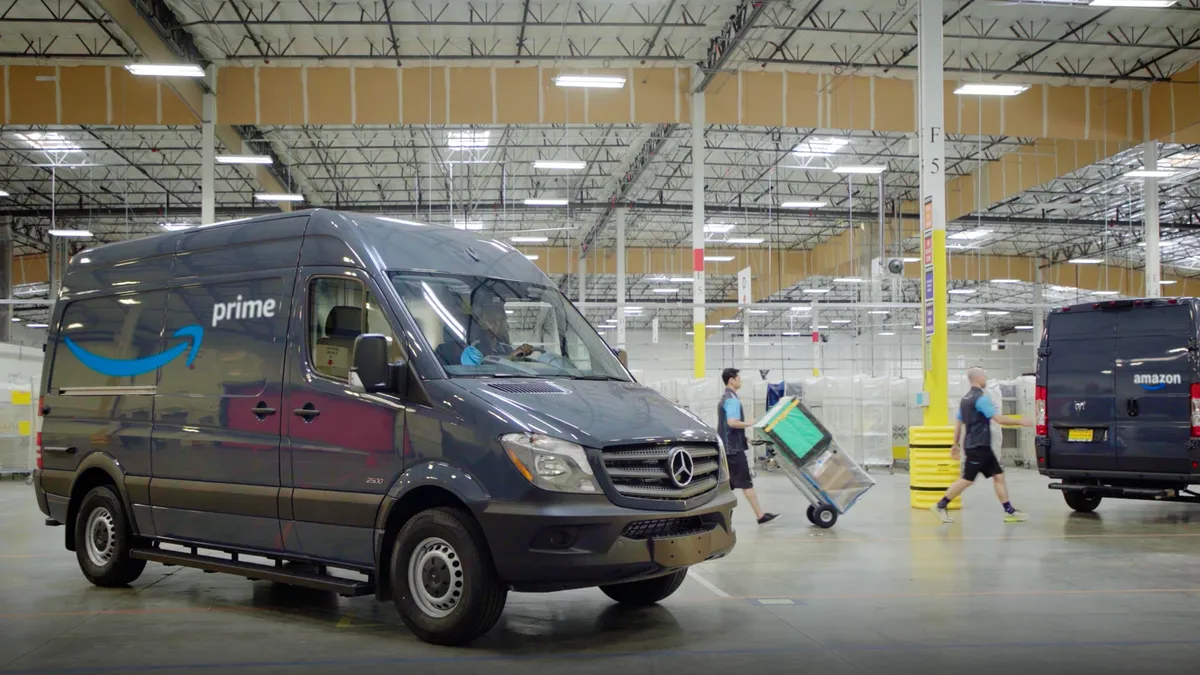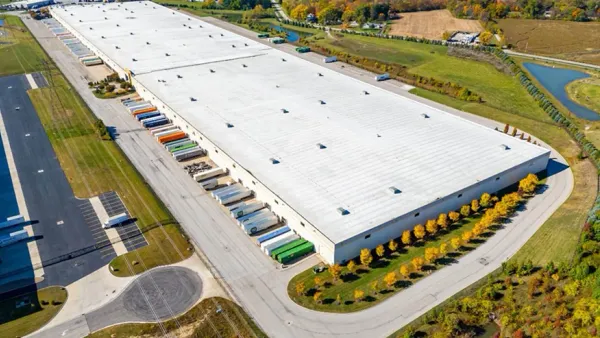Dive Brief:
- Amazon's shipping costs increased 49% in the first quarter compared to the same period last year, reaching $10.9 billion worldwide, according to earnings results issued Thursday.
- "It's taking longer to get things into our warehouse and out of our warehouse," CFO Brian Olsavsky said on the company's earnings call. Shipping speed on Prime items jumped from one to four days for essential items during the quarter ending March 31 — longer for non-essential items. "As we add capacity, we're trying to resume more normal operations, as far as the shipping of non-essential items and the speeding up of one-day shipments," Olsavsky said. Amazon hired 85,000 new workers in the first quarter after it had to suspend nonessential items coming into warehouses for more than a week.
- The company reported $600 million in COVID-19 related costs in Q1, most of which Olsavsky called "people costs," meaning increased compensation and "relief funds" for employees, along with the cost of decreased productivity. Operational expenses, such as personal protective equipment and cleaning services, are also included, which will continue and increase in the second quarter. "Under normal circumstances, in this coming Q2, we’d expect to make some $4 billion or more in operating profit. But these aren’t normal circumstances. Instead, we expect to spend the entirety of that $4 billion, and perhaps a bit more, on COVID-related expenses getting products to customers and keeping employees safe," CEO Jeff Bezos said in a statement.

Dive Insight:
Olsavsky pointed out that other spikes in Amazon sales volume, like holidays and Prime Day, require months of planning. Without the ability to plan, March's orders overwhelmed the company to the point where Amazon had to take steps to turn down the volume of incoming stock and adjust expectations for outgoing orders.
Operationally, the company was caught off guard, but the expense of it all fell very close to what Amazon expected in Q1 — just for different reasons.
Olsavsky said the cost of shipping in Q1 was in line with the expectations for the $1 billion in continuing costs of one-day Prime. After initially underplaying the operational shift for one-day Prime, Amazon has spent billions each quarter reshuffling inventory and growing its fulfillment and transportation capacity since debuting the condensed timeline in Q2 2019. In 2020, all of that spending went instead to keeping goods flowing in and out of warehouses, at much slower speeds, without the cost efficiency the system was designed to deliver.

"And we're glad we've made that investment, but we don't actually see savings because we're still shipping things once they're available very quickly to customers," Olsavsky said.
Pandemic or no pandemic, Amazon's unyielding shipping cost growth is still not a big problem in the eyes of analysts since retail sales are booming (up 26% year over year in Q1).
“Amazon’s Q1 performance, with explosive topline retail growth more than offset by the costs involved with its ongoing push for ever faster delivery speed, in addition to some increased costs resulting from the coronavirus, is in line with our reduced expectations from an operating income perspective, as Q1 2019 was a historically high quarter, with $2.3 billion in retail operating income,” Moody’s lead Amazon analyst Charlie O’Shea said in an email. The growing profitability of Amazon Web Services, which now represent 17% of retail revenue, makes up for the shipping costs, O'Shea said.
But second-quarter results could be very different.
The company hired an additional 90,000 workers at the beginning of Q2, which could mean some of the fulfillment capacity constraints will resolve. Though the major spike in order demand began in early March — two-thirds of the way through the quarter, according to Olsavsky.
Additionally, Q2 will mark one year since one-day Prime expenses began increasing. Understanding the success of the program in the current environment, though, could be difficult. Without the pandemic, Olsavsky said this is the time when the efficiencies would reveal themselves. With the pandemic still ongoing, that work may be less visible in the balance sheet.
On the bright side, with the added capacity, topline sales could be even higher in Q2, according to Martin Garner, COO of CCS Insight.
"[E]commerce in 1Q20 may have been held back by supply and logistics issues, which could have had a material effect - possibly Amazon could have sold a lot more than it actually did," Garner said in an emailed statement.
Amazon expects operating income in the second quarter to come in somewhere between $1.5 billion and a $1.5 billion loss, with an additional $4 billion in COVID-19 costs.














